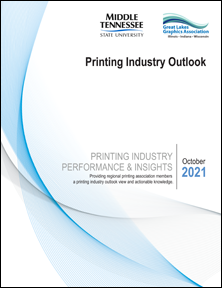 By Dr. Ralph Williams Jr.
By Dr. Ralph Williams Jr.
Associate Professor of Management
Jones College of Business
Middle Tennessee State University
and Dr. Richard Tarpey
Assistant Professor of Management
Jones College of Business
Middle Tennessee State University
Posted April 28, 2022
_____________________
Here’s a formula:
Paper mills producing less printing paper + pandemic-related shipping problems from overseas + labor shortages and strikes at mills + an increase in demand = significant delivery delays, some unavailable products, and significantly higher costs.
A few years ago, who could have imagined that our industry would face these paper supply issues?
In our October 2021 Printing Industry Performance and Insights (PIPI) study, we explored how supply chain problems affected our industry and how high-performing firms reacted to these issues. Recently, we stepped back and took a deeper look at our data to consider what printing company leaders might learn from a 30-thousand-foot overview. What’s the big takeaway?
Applying more sophisticated statistical analysis reinforced what we saw in our first look at the data: higher-performing firms proactively address paper supply issues. They are preemptive in their approach, seeking actions that forestall future disruptions. This strategy contrasts with a reactive approach – applying band-aids when a problem surfaces. Here are examples of proactive supply-chain tactics:
- Seeking relationships with alternative suppliers, even when solid relationships are present.
- Discussing future projects with customers and negotiating plans to order paper well ahead of when the project is ready to start.
- Have scheduled meetings with suppliers to discuss the current situation and have open-ended, creative discussions of potential approaches.
- Aggressively seek to reduce waste.
- Continuously and objectively assess suppliers’ commitment to your firm and your trust in them.
- Review your history of purchases, consider your sales forecast, and build a paper inventory.
- Continuously monitor relevant financial ratios – such as days-in-inventory and days-in-accounts payable – and adjust as needed.
So, what’s the big takeaway from all this? Be Proactive!
One would think the pandemic taught company leaders to be more proactive in preparing for “black swan” events. However, consider prior events that significantly disrupted supply chains in other industries, such as the Southeast Asia tsunami in 2004 or the Tohoku earthquake and subsequent tsunami in 2011. After these events, many companies discussed the need to be more proactive and more diligent with their risk management strategies, However, 10-20 years later, many had not taken significant measures toward hardening and insulating their supply chain. While it would have been impossible to foresee or mitigate a total shut-down of the global economy, many companies failed to learn from these past events how to undertake a basic proactive approach.
Let’s expand this “proactive approach” beyond the supply chain. What can you do to prompt “proactive thinking” by your team from a broad view of your firm?
Most are familiar with “SWOT” (Strengths, Weaknesses, Opportunities, and Threats). But how many of you apply SWOT in your leadership? In consulting printing firms, I found SWOT discussions especially effective in prompting proactive thinking. Indeed, looking back, I should have applied SWOT more in the three printing companies I led. Consider discussing these questions with your team regularly.
- What are our internal strengths (something we do well), and how can we use those strengths to serve our customers better and attract new business?
- What are our internal weaknesses (competitive disadvantages), and what is our plan to address those weaknesses?
- What are potential market opportunities for our company, and what’s our plan to leverage those opportunities?
- What are external threats to the company’s well-being, and what’s our plan to prepare for those possible occurrences?
Bottom line… from the current paper supply-chain issues, grow your team’s ability to think proactively on an ongoing basis. Consider discussing SWOT monthly to prompt proactive thinking. Leaders, take a positive away from the present paper mess!
_____________________
(GLGA members may download the PIPI reports for free from the Members Only area of this website. Click here to access the reports. (You will need to log in with your GLGA user name and password.)

